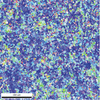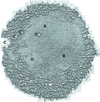issue contents
June 2023 issue

Cover illustration: Roder et al. [J. Appl. Cryst. (2023), 56, 776–786] have characterized 4H-silicon carbide wafers with synchrotron white-beam X-ray topography in back-reflection and transmission geometry to investigate the dislocation formation and propagation during growth.
research papers
Open  access
access
 access
accessA versatile reactor for in situ X-ray scattering studies of solvothermal reactions is presented, capable of providing data with millisecond time resolution
Download citation


Download citation


The incommensurate structure of Bi4BO7X (X = Cl and Br) is deceptively close to the commensurate fourfold a × b × 4c superstructure due to the extreme closeness of the q vector to (0,0,¼). The X− and BO33− anions between litharge-derived [Bi4O4]4+ layers alternate in a complex sequence.
Open  access
access
 access
accessUsing neutron powder diffraction on W-type hexaferrites, planar magnetic ordering described in Cm′cm′ was found for SrCo2Fe16O27 and SrCoZnFe16O27, while SrZn2Fe16O27 had uniaxial ordering described in P63/mm′c′. Thermomagnetic measurements above room temperature also indicated magnetic transitions for SrCo2Fe16O27 and SrCoZnFe16O27.
Open  access
access
 access
accessIdentifying the impurities that are able to promote the selection of specific gypsum twin laws has relevance for geological studies aimed at interpreting the gypsum depositional environments in ancient and modern deposits. The results of this study provide new insights into the mineralogical implications of twinned gypsum crystals and should help future research to make a better use of the twin laws observed in gypsum in ancient sedimentary successions as a proxy for the chemistry of the original brine.
Open  access
access
 access
accessAn extensive density functional theory analysis is reported of the crystal-chemical properties, electronic band structure, and optical (absorption and electron energy-loss spectra) and phonon properties of bulk and mono- and bilayer molybdenite, a transition metal dichalcogenide with important applications in semiconductor technology. This mineral is characterized by virtually infinite bidimensional layers of MoS2 (with covalent Mo—S bonds) held together by weak dispersive forces, explaining the easy cleavage of the (001) surfaces.
Open  access
access
 access
accessAn integrated method using analytical ultracentrifugation (AUC) and small-angle scattering (SAS), AUC–SAS, has been developed for the structural analysis of a biomacromolecule in solution. In this study, the first version of AUC–SAS is improved upon so as to be applicable to a solution with a large number of aggregates.
Open  access
access
 access
accessThe first real-world neutron diffraction data have been collected with one of the POWTEX detectors (FRM II, Garching, Germany) mounted for testing at the Spallation Neutron Source (Oak Ridge National Laboratory, USA). They allow for angular- and wavelength-dispersive Rietveld refinement using a modified version of GSAS-II.
Open  access
access
 access
accessIn this article, highly oriented small structures of gallium nitride grown on top of silicon nano-pillars are characterized by dark-field X-ray microscopy for optoelectronic applications such as micro-LEDs.
The effect of nitrogen partial pressure on an Ni/Ti neutron supermirror prepared by magnetron sputtering was investigated, revealing that the crystallization and interface performance on Ni/Ti thin films can be regulated by changing the nitrogen content of the sputtering gas.
Open  access
access
 access
accessA combined approach of scanning 3D X-ray diffraction and phase contrast tomography has been used to study the hydration of calcium sulfate hemihydrate to form gypsum. This approach was found to be a powerful tool that permitted – for the first time – coupling of detailed crystallographic and morphological information on the hemihydrate–gypsum transition observed in situ.
Open  access
access
 access
accessNeutron imaging enhanced by the retrieval of propagation-based phase contrast is described.
In small-angle scattering, the orientation of long thin particles often results in anisotropic two-dimensional scattering patterns, for which the anisotropy can be quantified through simple anisotropy factors. This work provides practitioners with information on the various methods for determining the anisotropy, including their limitations and recommended applications.
A new X-ray based method for studying nanodomain configuration in ferroic materials in the form of thin films is proposed, and its efficiency on classical functional antiferroelectric material PbZrO3 is demonstrated.
Open  access
access
 access
accessPrevious studies suggested that the silicon lattice spacing measured by X-ray interferometry might refer to the crystal surface. To confirm this result and to support experimental investigations of the matter, this paper gives a comprehensive analytical model of the operation of a triple-Laue interferometer having one of the splitting and recombining crystals bent.
Open  access
access
 access
accessThe operation model of a triple-Laue interferometer having one of the splitting and recombining crystals bent predicts that the phase-contrast topography detects the displacement field of the inner crystal surfaces. Therefore, it predicts that opposite bendings must result in the observation of opposite strains. This paper reports on the experimental confirmation of this prediction.
Open  access
access
 access
accessA statistical approach is developed for handling some standard problems involving orientation relationships. The approach is based on directional statistics.
Open  access
access
 access
accessAn algorithm for macrozone characterization in titanium alloys based on crystal misorientation criteria is presented and applied to electron backscatter diffraction (EBSD) data sets of titanium forgings.
Open  access
access
 access
accessA novel algorithm, based on a proper orthogonal decomposition and incorporating inequality constraints, is proposed to map out the different phases of a heterogenous material and simultaneously yield missing diffraction spectral information. An experimental case study of a three-phase NiTi shape-memory alloy under tensile loading illustrates the presented methodology.
Open  access
access
 access
accessThis work describes the influence of crystallographic orientation on dislocation arrangements during primary and secondary creep of polycrystalline Al and Al–Mg.
Open  access
access
 access
accessIn this work, the determination of dislocation arrangements in 4H-silicon carbide (4H-SiC), their evolution in the growth direction and their influence on the crystal lattice properties are presented.
Open  access
access
 access
accessSelected recent advances in small-angle X-ray and neutron scattering are highlighted, together with some of the hard material applications they serve in the areas of manufacturing, energy and climate change. This paper is associated with work presented at the 18th International Conference on Small-Angle Scattering, Campinas, Brazil, September 2022 (SAS 2022).
Open  access
access
 access
accessIn situ small-angle X-ray scattering was used to identify structural changes during thermal treatment of an ordered mesoporous carbon precursor material, synthesized via direct soft templating, to remove Pluronic F127 surfactant from a resorcinol–formaldehyde frame.
Open  access
access
 access
accessImplementation of grain mapping by diffraction contrast tomography has been demonstrated on a conventional tomography setup with two common detectors (CCD and flat panel). Typical grain mapping performance has been characterized for the related experimental conditions and setup, and grain reconstructions from diffraction images acquired with different exposure times demonstrate the possibility of fast grain mapping with laboratory-based X-rays.
Open  access
access
 access
accessThis work demonstrates the use of a broad energy bandwidth multilayer mirror monochromator for X-ray total scattering (TS) measurements and pair distribution function (PDF) analysis. This type of measurement could facilitate faster time-resolved TS and PDF studies.
teaching and education
Open  access
access
 access
accessThe most commonly used functions for calculating or correcting step-scan and integrated intensities of a powder diffraction pattern are presented in an educational manner with the support of Mathematica scripts. The scripts can be easily used by interested readers to explore the effects of different instrumental and sample parameters.
computer programs
Open  access
access
 access
accessinserexs is an open-source program that allows resonant elastic X-ray scattering users to choose the best conditions to determine any parameter of interest (atomic position, occupancy etc.) before an experiment is carried out.
Open  access
access
 access
accessSpatDistCalib: a GUI Python software for spatial-distortion correction of 2D detectors using splines
In this article, Python software with a graphical user interface (GUI) for spatial-distortion correction, using any regular grid as the calibration pattern and producing spline files, is presented.
Open  access
access
 access
accessThis article presents CyRSoXS – an open-source virtual instrument that uses GPUs to simulate polarized resonant soft X-ray scattering (P-RSoXS) patterns from real-space material representations. It is significantly faster than the current state-of-the-art software, and it enables quantitative extraction of orientation information from P-RSoXS data. This enables a wide range of applications, including pattern fitting, co-simulation, data exploration, machine learning workflows and multi-modal data assimilation approaches.
This work provides an online calculator (https://bfip.crystalstructure.cn) to characterize polyhedral distortion on the basis of the best fitted idealized polyhedron (BFIP) method. This method can determine any subtle change between distorted and corresponding idealized polyhedra.
Open  access
access
 access
accessA new program named EDP2PDF is developed for the conversion of an electron diffraction pattern into a pair distribution function for materials structure analysis.
laboratory notes
Open  access
access
 access
accessA `catcher' based on a revolving cylindrical collector is described.
book reviews
Free 


 journal menu
journal menu




















































